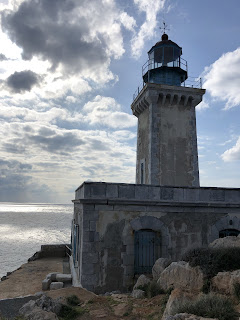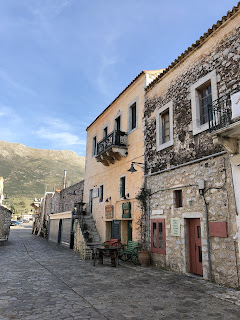We have reached something of a milestone on our journey. Sitting overlooking the sea by the disused lighthouse at the tip of Cape Matapan, we were at the southernmost point of our journey, 3,381 miles from Nordkapp, the most northerly place on our trip. While we will be zig-zagging around Greece for a few weeks more, our general direction from now on will be northwards.
 |
| The lighthouse at the tip of the cape |
It was off Cape Matapan in 1941 that a sea battle between a British and Italian fleet effectively ended the role of the Italian navy in the Eastern Mediterranean. One of the crew on board HMS Valiant, a Royal Navy battleship, was my father, George Richards Serpell who was serving in the Royal Marines. Also among the crew was a midshipman named Philip Mountbatten. I wonder what happened to him.
Our journey down to the Cape had taken us from the village of Karavostasi where we had enjoyed a fine meal in the O Faros taverna, three courses and wine for €40. We made our way south to the little town of Areopolis, named for Ares the God of War, where we stocked up on some provisions before heading onwards. The Mani peninsula must be one of Greece’s best kept secrets. It is here that the Greek War of Independence first kicked off in 1821 in a bid to overthrow the grip of the Ottoman Empire.
 |
| Not much space for agriculture |
Previously the area had been home to a number of local clans who spent most of their time warring with each other over the few patches of fertile land in a predominantly rocky and mountainous landscape. In order to protect themselves people lived in towers, all the better to lob stones and cannonballs down on their neighbours. As our road climbed and dipped through a series of vertiginous hairpin bends we passed dozens of these towers, some in ruins, others converted to modern accommodation. The hillsides were dotted with an amazing number of churches, each the property of a specific clan. Obviously it was not the done thing to spend Sunday praying alongside someone you planned to kill the following morning.
 |
| Vathia is one of the most spectacular fortified villages |
 |
| A little street of the dead |
 |
| Anyone in? |
 |
| Temple of Poseidon |
After a very windy night, due to the weather rather than my chickpea, sausage and chicken casserole, we set off on the half hour hike to the lighthouse and the end of the Greek mainland. On the way we passed the ruins of Roman settlements, including two mosaic floors still in good condition after the best part of 2,000 years exposure to the elements. We were able to let the spaniels have a good run across the scrub, only hooking them up to their leads as the path approached the top of the steep cliffs by the lighthouse.
 |
| Plenty of room for spaniels to run |
 |
| Beautiful stone buildings in Areopolis |
We had a wander down some quiet roads with the pups before stocking up in the local supermarket. By now the dirty laundry was stacking up so we decided to drive across the peninsula to a campsite which held the promise of a washing machine. Here we will spend a couple of days getting the washing done and having a bit of a clean up. We are also close to a beach which pleases the spaniels so we sleep tonight to the sounds of the waves on the sand.
 |
| One of several churches in Areopolis |
 |
| A good crop of rocks this year |
 |
| Talking litter bins.... |
 |
| .....have hidden depths |

What beautiful scenery..
ReplyDeleteThe Mani is absolutely spectacular, like Skye with olive trees in places, like a side of the Grand Canyon in others
DeleteFantastic! A definite MUST one day.
ReplyDelete